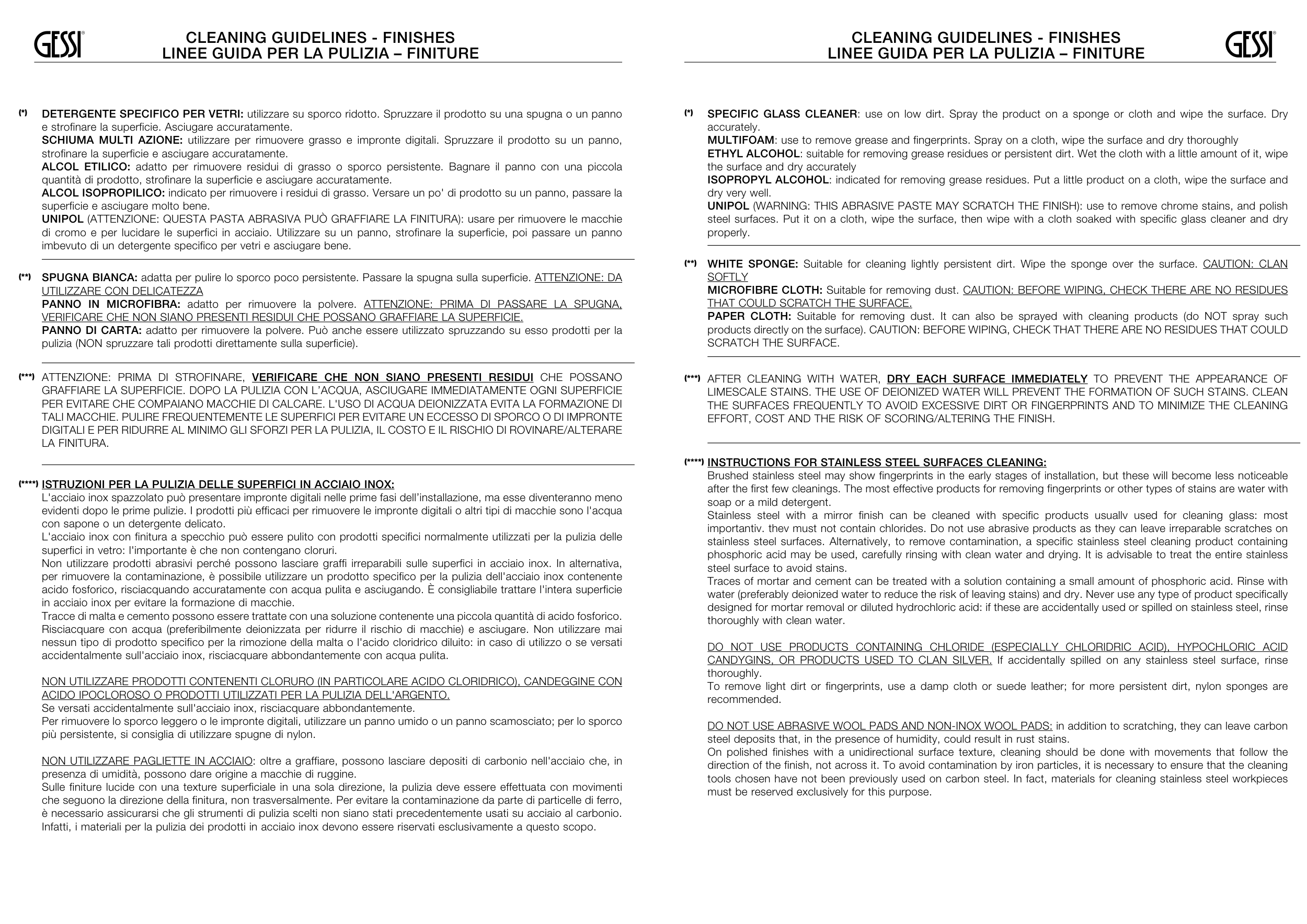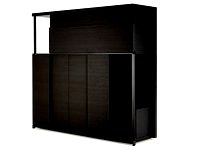SPECIFIC GLASS CLEANER: use on low dirt. Spray the product on a sponge or cloth and wipe the surface. Dry
accurately.
MULTIFOAM: use to remove grease and fingerprints. Spray on a cloth, wipe the surface and dry thoroughly
ETHYL ALCOHOL: suitable for removing grease residues or persistent dirt. Wet the cloth with a little amount of it, wipe
the surface and dry accurately
ISOPROPYL ALCOHOL: indicated for removing grease residues. Put a little product on a cloth, wipe the surface and
dry very well.
UNIPOL (WARNING: THIS ABRASIVE PASTE MAY SCRATCH THE FINISH): use to remove chrome stains, and polish
steel surfaces. Put it on a cloth, wipe the surface, then wipe with a cloth soaked with specific glass cleaner and dry
properly.
DETERGENTE SPECIFICO PER VETRI: utilizzare su sporco ridotto. Spruzzare il prodotto su una spugna o un panno
e strofinare la superficie. Asciugare accuratamente.
SCHIUMA MULTI AZIONE: utilizzare per rimuovere grasso e impronte digitali. Spruzzare il prodotto su un panno,
strofinare la superficie e asciugare accuratamente.
ALCOL ETILICO: adatto per rimuovere residui di grasso o sporco persistente. Bagnare il panno con una piccola
quantità di prodotto, strofinare la superficie e asciugare accuratamente.
ALCOL ISOPROPILICO: indicato per rimuovere i residui di grasso. Versare un po' di prodotto su un panno, passare la
superficie e asciugare molto bene.
UNIPOL (ATTENZIONE: QUESTA PASTA ABRASIVA PUÒ GRAFFIARE LA FINITURA): usare per rimuovere le macchie
di cromo e per lucidare le superfici in acciaio. Utilizzare su un panno, strofinare la superficie, poi passare un panno
imbevuto di un detergente specifico per vetri e asciugare bene.
WHITE SPONGE: Suitable for cleaning lightly persistent dirt. Wipe the sponge over the surface. CAUTION: CLAN
SOFTLY
MICROFIBRE CLOTH: Suitable for removing dust. CAUTION: BEFORE WIPING, CHECK THERE ARE NO RESIDUES
THAT COULD SCRATCH THE SURFACE.
PAPER CLOTH: Suitable for removing dust. It can also be sprayed with cleaning products (do NOT spray such
products directly on the surface). CAUTION: BEFORE WIPING, CHECK THAT THERE ARE NO RESIDUES THAT COULD
SCRATCH THE SURFACE.
SPUGNA BIANCA: adatta per pulire lo sporco poco persistente. Passare la spugna sulla superficie. ATTENZIONE: DA
UTILIZZARE CON DELICATEZZA
PANNO IN MICROFIBRA: adatto per rimuovere la polvere. ATTENZIONE: PRIMA DI PASSARE LA SPUGNA,
VERIFICARE CHE NON SIANO PRESENTI RESIDUI CHE POSSANO GRAFFIARE LA SUPERFICIE.
PANNO DI CARTA: adatto per rimuovere la polvere. Può anche essere utilizzato spruzzando su esso prodotti per la
pulizia (NON spruzzare tali prodotti direttamente sulla superficie).
AFTER CLEANING WITH WATER, DRY EACH SURFACE IMMEDIATELY TO PREVENT THE APPEARANCE OF
LIMESCALE STAINS. THE USE OF DEIONIZED WATER WILL PREVENT THE FORMATION OF SUCH STAINS. CLEAN
THE SURFACES FREQUENTLY TO AVOID EXCESSIVE DIRT OR FINGERPRINTS AND TO MINIMIZE THE CLEANING
EFFORT, COST AND THE RISK OF SCORING/ALTERING THE FINISH.
ATTENZIONE: PRIMA DI STROFINARE, VERIFICARE CHE NON SIANO PRESENTI RESIDUI CHE POSSANO
GRAFFIARE LA SUPERFICIE. DOPO LA PULIZIA CON L’ACQUA, ASCIUGARE IMMEDIATAMENTE OGNI SUPERFICIE
PER EVITARE CHE COMPAIANO MACCHIE DI CALCARE. L'USO DI ACQUA DEIONIZZATA EVITA LA FORMAZIONE DI
TALI MACCHIE. PULIRE FREQUENTEMENTE LE SUPERFICI PER EVITARE UN ECCESSO DI SPORCO O DI IMPRONTE
DIGITALI E PER RIDURRE AL MINIMO GLI SFORZI PER LA PULIZIA, IL COSTO E IL RISCHIO DI ROVINARE/ALTERARE
LA FINITURA.
INSTRUCTIONS FOR STAINLESS STEEL SURFACES CLEANING:
Brushed stainless steel may show fingerprints in the early stages of installation, but these will become less noticeable
after the first few cleanings. The most effective products for removing fingerprints or other types of stains are water with
soap or a mild detergent.
Stainless steel with a mirror finish can be cleaned with specific products usuallv used for cleaning glass: most
importantiv. thev must not contain chlorides. Do not use abrasive products as they can leave irreparable scratches on
stainless steel surfaces. Alternatively, to remove contamination, a specific stainless steel cleaning product containing
phosphoric acid may be used, carefully rinsing with clean water and drying. It is advisable to treat the entire stainless
steel surface to avoid stains.
Traces of mortar and cement can be treated with a solution containing a small amount of phosphoric acid. Rinse with
water (preferably deionized water to reduce the risk of leaving stains) and dry. Never use any type of product specifically
designed for mortar removal or diluted hydrochloric acid: if these are accidentally used or spilled on stainless steel, rinse
thoroughly with clean water.
DO NOT USE PRODUCTS CONTAINING CHLORIDE (ESPECIALLY CHLORIDRIC ACID), HYPOCHLORIC ACID
CANDYGINS, OR PRODUCTS USED TO CLAN SILVER. If accidentally spilled on any stainless steel surface, rinse
thoroughly.
To remove light dirt or fingerprints, use a damp cloth or suede leather; for more persistent dirt, nylon sponges are
recommended.
DO NOT USE ABRASIVE WOOL PADS AND NON-INOX WOOL PADS: in addition to scratching, they can leave carbon
steel deposits that, in the presence of humidity, could result in rust stains.
On polished finishes with a unidirectional surface texture, cleaning should be done with movements that follow the
direction of the finish, not across it. To avoid contamination by iron particles, it is necessary to ensure that the cleaning
tools chosen have not been previously used on carbon steel. In fact, materials for cleaning stainless steel workpieces
must be reserved exclusively for this purpose.
ISTRUZIONI PER LA PULIZIA DELLE SUPERFICI IN ACCIAIO INOX:
L'acciaio inox spazzolato può presentare impronte digitali nelle prime fasi dell’installazione, ma esse diventeranno meno
evidenti dopo le prime pulizie. I prodotti più efficaci per rimuovere le impronte digitali o altri tipi di macchie sono l'acqua
con sapone o un detergente delicato.
L'acciaio inox con finitura a specchio può essere pulito con prodotti specifici normalmente utilizzati per la pulizia delle
superfici in vetro: l'importante è che non contengano cloruri.
Non utilizzare prodotti abrasivi perché possono lasciare graffi irreparabili sulle superfici in acciaio inox. In alternativa,
per rimuovere la contaminazione, è possibile utilizzare un prodotto specifico per la pulizia dell'acciaio inox contenente
acido fosforico, risciacquando accuratamente con acqua pulita e asciugando. È consigliabile trattare l'intera superficie
in acciaio inox per evitare la formazione di macchie.
Tracce di malta e cemento possono essere trattate con una soluzione contenente una piccola quantità di acido fosforico.
Risciacquare con acqua (preferibilmente deionizzata per ridurre il rischio di macchie) e asciugare. Non utilizzare mai
nessun tipo di prodotto specifico per la rimozione della malta o l'acido cloridrico diluito: in caso di utilizzo o se versati
accidentalmente sull'acciaio inox, risciacquare abbondantemente con acqua pulita.
NON UTILIZZARE PRODOTTI CONTENENTI CLORURO (IN PARTICOLARE ACIDO CLORIDRICO), CANDEGGINE CON
ACIDO IPOCLOROSO O PRODOTTI UTILIZZATI PER LA PULIZIA DELL'ARGENTO.
Se versati accidentalmente sull'acciaio inox, risciacquare abbondantemente.
Per rimuovere lo sporco leggero o le impronte digitali, utilizzare un panno umido o un panno scamosciato; per lo sporco
più persistente, si consiglia di utilizzare spugne di nylon.
NON UTILIZZARE PAGLIETTE IN ACCIAIO: oltre a graffiare, possono lasciare depositi di carbonio nell'acciaio che, in
presenza di umidità, possono dare origine a macchie di ruggine.
Sulle finiture lucide con una texture superficiale in una sola direzione, la pulizia deve essere effettuata con movimenti
che seguono la direzione della finitura, non trasversalmente. Per evitare la contaminazione da parte di particelle di ferro,
è necessario assicurarsi che gli strumenti di pulizia scelti non siano stati precedentemente usati su acciaio al carbonio.
Infatti, i materiali per la pulizia dei prodotti in acciaio inox devono essere riservati esclusivamente a questo scopo.
(*)
(*)
(**)
(**)
(***)
(***)
(****)
(****)
CLEANING GUIDELINES - FINISHES
LINEE GUIDA PER LA PULIZIA – FINITURE
CLEANING GUIDELINES - FINISHES
LINEE GUIDA PER LA PULIZIA – FINITURE



